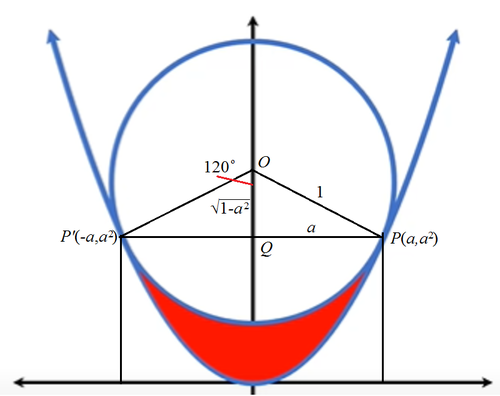Just a Circle in a Parabola
The figure shows a circle of radius 1 which is tangent to the curve y = x 2 at two points. Find the area of the red region.
An "indirect" hint: Ipx up zpv efufsnjof uif joufstfdujpo qpjout cfuxffo uif djsdmf boe uif qbsbcpmb?
(I know that some of you might not want to see it so I purposely encoded the text, just shift each alphabet one to the right as in a → b ).
The answer is 0.252.
This section requires Javascript.
You are seeing this because something didn't load right. We suggest you, (a) try
refreshing the page, (b) enabling javascript if it is disabled on your browser and,
finally, (c)
loading the
non-javascript version of this page
. We're sorry about the hassle.
2 solutions
Well done! Sorry if you found the hint purposeless, I'll make it better next time.
We can solve this problem without using integration and the equation of a circle.

Because of symmetry, we can assume that the two points where the circle is tangent to the parabola be P ( a , a 2 ) and P ′ ( − a , a 2 ) . We need only consider P ( a , a 2 ) . The gradient at P is d x d x 2 = x 2 ∣ ∣ x = a = 2 a . The gradient of the normal at P is then 2 a m = − 1 ⟹ m = − 2 a 1 . And we note that in △ O P Q , a 1 − a 2 = 2 a 1 ⟹ a = 2 3 .
Knowing that the area of under an inverted parabola is 3 2 that of the rectangle inscribing it, the area of parabola for y ∈ [ 0 , a 2 ] , A p = 3 2 ( 2 a ) a 2 = 3 4 a 3 = 2 3 and the area of the red region is:
A red = A p − ( 3 π − a 1 − a 2 ) = 2 3 − 3 π + 4 3 ≈ 0 . 2 5 2 Note that ∠ P O P ′ = 1 2 0 ∘
The indirect hint is to let us know that we need to find the points of tangent so that we can find the area in question.
@Ethan Mandelez , we don't need to mention that answer should be in three significant figures because the system is set for it. This means that if we ask for more significant figures would be meaningless.
Ok, thank you!
The statement "Knowing that the area of under a parabola... " is a result of integration only. It can never be known without using calculus.
Log in to reply
Yes, I agree and I knew. I was just trying to tell learners that we must also memorize theorems. Like volume of a sphere for example.
Let the center of the circle be at ( 0 , a ) and it's equation be x 2 + ( y − a ) 2 = 1 . Let the point of intersection of this circle and the parabola y = x 2 in the first quadrant be ( h , h 2 ) . Then
h 4 − ( 2 a − 1 ) h 2 + a 2 − 1 = 0 . Since the two curves touch each other at this point,
( 2 a − 1 ) 2 = 4 × 1 × ( a 2 − 1 ) ⟹ a = 4 5 , h = 2 3 .
Hence the area of the red region is
2 ∫ 0 2 3 ( 4 5 − 1 − x 2 − x 2 ) d x = 4 3 3 − 3 π ≈ 0 . 2 5 1 8 4 .
The hint : How to you determine the intersection points between the circle and the parabola is completely meaningless.